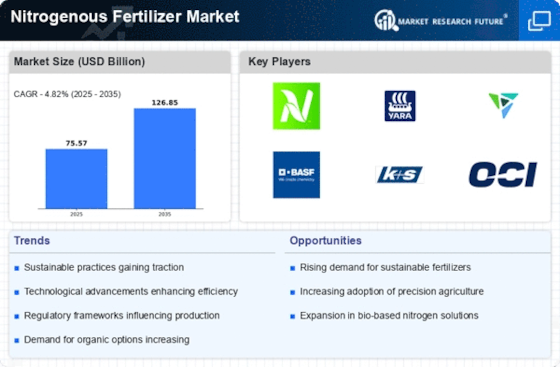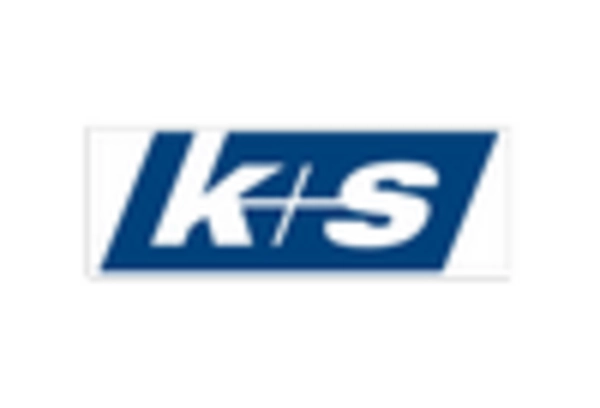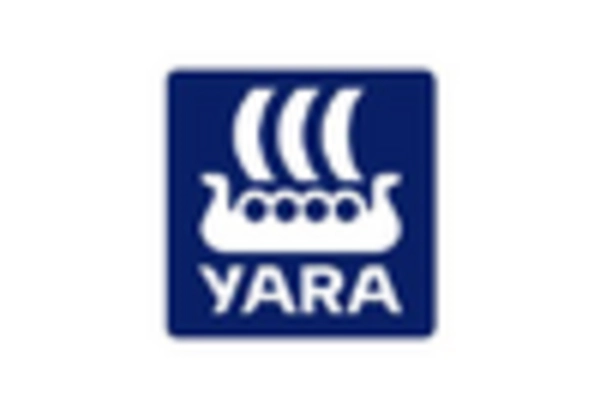Increasing Food Demand
The rising global population and changing dietary preferences are driving an unprecedented demand for food production. This trend is particularly evident in developing regions, where urbanization and economic growth are leading to higher consumption of protein-rich foods. Consequently, the Nitrogenous Fertilizer Market is experiencing heightened demand as farmers seek to enhance crop yields to meet this growing need. According to recent agricultural reports, the demand for nitrogenous fertilizers is projected to increase by approximately 3% annually over the next five years. This growth is likely to be fueled by the necessity for efficient agricultural practices that can sustain food production levels amid limited arable land.
Rising Agricultural Exports
The expansion of agricultural exports is contributing to the growth of the Nitrogenous Fertilizer Market. Countries that are major agricultural producers are increasingly focusing on enhancing their export capabilities to meet international demand. This trend necessitates the use of nitrogenous fertilizers to boost crop yields and ensure high-quality produce. As a result, the market is expected to see a surge in demand for nitrogenous fertilizers, particularly in regions where agricultural exports are a key economic driver. Projections indicate that the agricultural export market will continue to grow, further supporting the nitrogenous fertilizer sector.
Government Initiatives and Subsidies
Various governments are implementing policies and providing subsidies to promote the use of nitrogenous fertilizers in agriculture. These initiatives aim to enhance food security and support farmers in adopting modern agricultural practices. For instance, several countries have introduced financial incentives for the purchase of nitrogenous fertilizers, which has led to increased usage among farmers. The Nitrogenous Fertilizer Market is thus benefiting from these supportive measures, as they encourage the adoption of fertilizers that can improve crop productivity. Reports indicate that government spending on agricultural subsidies is expected to rise, further bolstering the market for nitrogenous fertilizers.
Technological Innovations in Fertilizer Production
Advancements in fertilizer production technologies are playing a crucial role in shaping the Nitrogenous Fertilizer Market. Innovations such as precision agriculture and enhanced efficiency fertilizers are enabling farmers to optimize nutrient application, thereby improving crop yields while minimizing environmental impact. The introduction of slow-release and controlled-release nitrogen fertilizers is particularly noteworthy, as these products can significantly reduce nitrogen losses to the environment. As a result, the market is witnessing a shift towards more sustainable fertilizer options, which are projected to capture a larger share of the nitrogenous fertilizer market in the coming years.
Environmental Regulations and Sustainability Concerns
Increasing awareness of environmental issues is prompting stricter regulations regarding fertilizer use. The Nitrogenous Fertilizer Market is adapting to these changes as stakeholders seek to balance agricultural productivity with environmental sustainability. Farmers are increasingly required to implement best management practices to minimize nitrogen runoff and its associated impacts on water quality. This shift is likely to drive demand for environmentally friendly nitrogenous fertilizers that comply with regulatory standards. Market analysts suggest that the trend towards sustainability will continue to influence product development and consumer preferences in the nitrogenous fertilizer sector.

















Leave a Comment